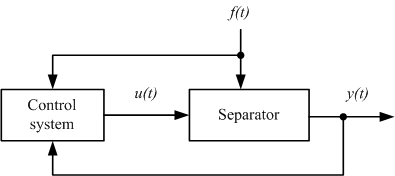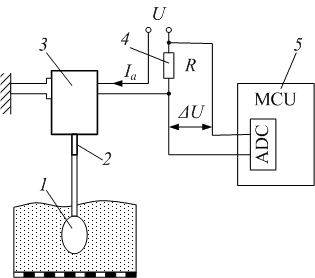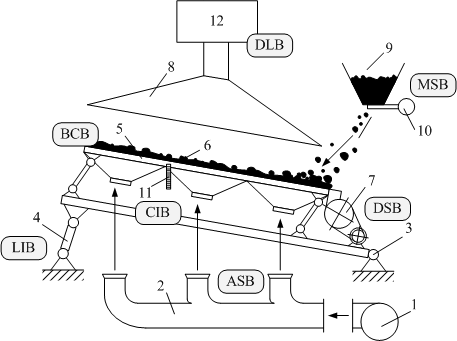
Faculty: Computer Information Technologies and Automation
Speciality: Automatic Control of Technological Processes
Theme of master's work: Automation of coal preparation process using vibration-pneumatic separator
 |
|
|
|
|
|||
|
Vadim Loginov Faculty: Computer Information Technologies and Automation Speciality: Automatic Control of Technological Processes Theme of master's work: Automation of coal preparation process using vibration-pneumatic separator |
|||||||
|
|
|
|
ABSTRACTof the Master's Qualification Work
|
| Parameter | Influence on process | Regulation |
|---|---|---|
| Feeder loading Qfeed |
Continuous giving and correct choice of quantity of initial coal provide effective work of a separator | Frequency management of a feeder drive |
| Air flow rate Qair |
Defines quality of products of enrichment. Provides necessary degree of bed fluidization | Manually |
| Frequency of air flow pulsations fВ |
Promotes the better bed fluidization, accelerates process of division and reduces to 25 % air flow rate | Frequency management of a drive of pulsators |
| Amplitude of shaking of a box Δ |
Influences degree of bed fluidization | Manually |
| Frequency of shaking of a box ω |
Influences degree of bed fluidization | Frequency management of a drive |
| Angle of a deck longitudinal inclination α |
Influences a thickness of bed and speed of movement of a material on a separator's deck | Manually |
| Angle of a deck cross inclination β |
Influences speed of unloading of the top (coal) layer of bed | Manually |
The primary goal of automatic control of vibration-pneumatic separators consists in operating mode choice at which the best branch of extraneous impurity from coal is provided at its minimum losses in a waste. Tab. 1 analysis shows that management of enrichment process on a separator consists of regulation of following key parameters [2]:
Structure scheme of control of vibration-pneumatic separator is shown on fig.3:

Figure 3. Structure scheme of control of separator
Changing granule structure of coal and its density is revolting influence f (t). Operating influence u (t) is presented by change of the air flow rate Qair, frequency ω and amplitude Δ of box shaking. The supervision vector y (t) is presented by target signals of measuring converters about concentrate ash content Аc, middle product Amid and waste Аw, and also about the degree of bed looseness.
Thus, management of a separator consists in operative change of values of parameters of operating influence depending on revolting factors for the purpose of reception of a quality product.
For normal course of enrichment process it is necessary to loosen rock mass and to lead it to condition of fluidization. Nowadays there are no the devices that allow to estimate degree of loosening of vibration-pneumatic separator's bed of a material. Thus, rate of loosening is the most important indicator on which depends the efficiency of separating ROM coal using vibration-pneumatic separator.
Now there are the devices intended for loosening measurement of bed of jigging machines. One of such devices – the device for automatic loosening measurement of bed of jigging machines, contains a float with lever system, the inductive gauge of loosening and the scheme for formation of a signal of measurement [4].
The device including immersed in bed probes, executed in the form of the cores strengthened in directing bearings [5] is known also. There is a device including a measuring element, established on an electric motor shaft. At immersing a measuring element in bed of a material and inclusion of the electric motor at the expense of braking of a shaft of the motor by bed grains there is a twisting moment which is transformed to deformation of an elastic measuring beam. Beam deformation is registered by strain gages [6].
However, the devices mentioned above are designed for application in conditions of jigging machines unlike which at vibration-pneumatic enrichment there is the vibrating field (created by shaking separator’s bed) that influences the accuracy of measurement.
I have developed a device of the automatic control of loosening rate for separator’s bed. The scheme of device is shown on fig.4. The device consists of the measuring element 1 strengthened on a shaft 2 of motor of direct current with independent excitation 3 which case is fixed motionlessly. The voltage drop on the constant resistor 4 (which is included in an electric motor chain) is sensed by analogue-digital converter (ADC) of the microcontroller unit (MCU) 5.

Figure 4. The device for measuring a loosening rate of vibrating-pneumatic separator
After applying the supply voltage U on a winding of an anchor of the motor, motor starts rotating, experiencing the moment of resistance MC depending on geometrical parameters of a measuring element 1 and loosening rate of bed of the investigated material ρ. The less loosened the bed of the material, the more is the resistance moment applied on a shaft 2 of electric motor 3. With growth of the moment of resistance on a shaft reduces a speed of rotation of the motor and therefore reduces the current Ia consumed by the motor. As loosening increases current of electric motor decreases. According to a current voltage drop on the resistor changes. This sag is transformed by ADC of the microcontroller. Then MCU forms a corresponding signal of management of a separator.
In the established operating mode pressure Ua (enclosed to an motor anchor) is counterbalanced by electromotive power (EMF) Е, induced in an anchor, and a potential drop in an anchor chain:
| Ua = U = E + Ia·(R + Ra ) = C·Φ·ωm + Ia·(Ra + R ) , | (1) |
Change of angular speed ω of a shaft under the influence of the resistance created by bed of a material (loosened to certain degree) leads to change of EMF E and, therefore current Ia.
Thus, it is possible to estimate loosening rate of separator's bed by measuring the current consumed by the electric motor of the device. Application of the developed device will allow to form operating influence for maintenance of high efficiency of a separator and an exit of a qualitative product of enrichment.
As I have shown earlier coal preparation plant based on vibration-pneumatic technology is effective. But efficiency can be raised. It is possible by elimination of its main lack – a hand control. The main machine of a plant (vibration-pneumatic separator) is subject to a considerable idle time. The reason - absence of executive mechanisms for change of technological parameters. Also there is no sensor for measuring bed's loosening and a control system of enrichment process. It leads to considerable influence of the human factor on efficiency of separation.
СThe control system can be constructed as a set of blocks. Each of blocks is responsible for measurement and change of certain parameters of a separator. All blocks co-operate with the central device. This device (according to algorithm) operates process of separation and creates inquiries and information reports to the operator.
On fig.5 the scheme of separator plant with the blocks located in it is shown. Following blocks are used for control:
Task of DLB is giving operator the information about dust collection system (serviceability of the fan, pressure in the pipeline and so forth). DSB measures and changes a mode separator's decks shaking. LIB and CIB measure and change accordingly longitudinal and cross-section angles of deck's inclination. ASB measures and changes parameters of an air supply mode (the air flow rate and air pulsations). MSB operates a feeder. BCB informs about a condition of bed of a material (measures the loosening).

Figure 5. Scheme of the separating plant[1]:
1 – the technological fan; 2 – air line; 3 – support; 4 – the elevating mechanism; 5 – deck;
6 – bed; 7 – shaker's drive; 8 – exhaust hood; 9 – storage bunker; 10 – feeder; 11 – lifting mechanism; 12 – air cleaning
The central unit (CU) interacts with each block by means of the two-wire communication line. It allows raising reliability of ht system (compared with more economic topology «the common bus»). CU interacts with the computer by RS-232 interface (fig.6). Also operator should have a possibility of a hand control through CU.

Figure 6. Structural schematic of control system
Use of computer will allow using a difficult model for efficient control of the process. Also gathering and an archiving of the data about separator functioning and visualization of a current state of the process is possible.
Creation of such system will results as follows:
Date of completion of the master's work: 01.12.2010. You may apply to the author or his scientific advisor for completed work after the mentioned date.